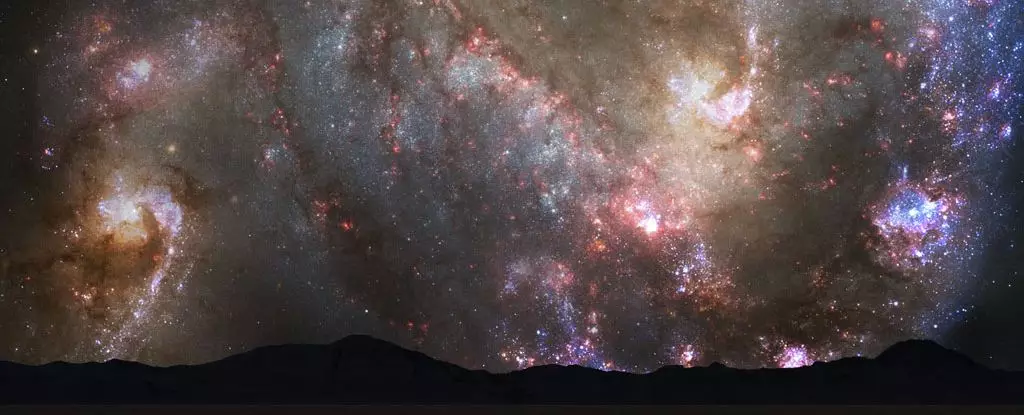For years, astronomers and astrophysicists have anticipated a cosmic event as monumental as the predicted collision between our Milky Way galaxy and its celestial neighbor, Andromeda. Commonly dubbed “Milkomeda,” this potential merging has stirred imaginations and incited scientific inquiry into the great beyond. However, recent research led by Till Sawala and a team at the University of Helsinki suggests that the supposed inevitability of this collision is more nuanced than previously believed. Instead of a black-and-white forecast of galactic doom, we are now faced with a fifty-fifty chance that these vast cosmic bodies may either collide or glide past one another in the cosmic sea.
Unpacking the Current Research
To reach this revelation, Sawala’s research team employed cutting-edge observational data from the Hubble and Gaia space telescopes, focusing on four significant members of the Local Group of galaxies: the Milky Way, Andromeda, the Triangulum Galaxy (M33), and the Large Magellanic Cloud (LMC). Given that our understanding of cosmic collisions hinges on the gravitational dance between these galaxies, the study delved into intricate simulations spanning the next ten billion years. This extensive timeframe was selected not only because it exceeds the longstanding predictions of a merger but also because it encapsulates the complexities of cosmic evolution over extensive periods.
In a striking departure from earlier conclusions, the team highlighted the intricate gravitational interactions between galaxies, demonstrating how the presence of M33 and LMC could dramatically alter interaction probabilities. As per their findings, under scenarios with just Milky Way and Andromeda, a collision occurred slightly less than half of the time. However, when introducing M33 into the mix, amalgamation probabilities surged to nearly two-thirds. Alternatively, integrating the LMC instead of M33 dampened the likelihood to about one-third. This quite sophisticated interplay showcases not only the complexity of our cosmic environment but also the inherent uncertainties that reign in celestial mechanics.
The Role of Uncertainty in Cosmic Predictions
One of the most intriguing aspects of Sawala’s findings is the inherent uncertainty surrounding cosmic events—a fundamental characteristic echoed throughout scientific inquiry, yet often overlooked in grand predictions. The further we extend our gaze into the future, the more factors emerge that could disrupt even the most robust models. Sawala’s assertion that the interactions between these galaxies could either lead to a merger or result in prolonged cosmic partnership underscores a meaningful truth: our understanding of the universe is far from definitive.
The varied outcomes discussed by Sawala—where Milky Way and Andromeda either entwine violently or continue their shared orbit for eons—graphically illustrate this uncertainty. The notion of having dynamic friction dictate the galactic dance indicates a reliance on external gravitational forces that can fluctuate unpredictably, potentially resulting in divergent evolutionary paths for both galaxies.
Implications for Cosmic Evolution and Humanity
Even as we hover at the threshold of numerous cosmic dilemmas, the research introduces a larger context for reflection regarding humanity’s place in the universe. The prospect of a galactic merger is awe-inspiring; it aligns with humankind’s ancient fascination with the cosmos while highlighting our relative insignificance within it. While the possibility of Milkomeda may seem daunting, we are reminded that these events unfold across vast time scales—an indication that the galaxy’s fate is not something to be feared in our lifetime, nor does it sum up our existence.
One pressing takeaway is this: as scientific tools and observational capabilities improve, more nuanced understandings will emerge. Future telescopes and data collecting methods may refine the measurements and simulation outreach, further elucidating this cosmic dance in ways we cannot yet imagine. This promises not merely more precise calculations but also a richer narrative about our universe that stretches beyond binary scenarios of merger or survival.
The Ongoing Journey of Discovery
Ultimately, the revelation that the fate of the Milky Way and Andromeda remains intricately unpredictable urges us to embrace a mindset of curiosity and exploration. As researchers investigate the cosmic environment that influences these interactions, they unearth stories about the universe as fantastically complex and multifaceted. Whether we face a future where our galaxy melds with Andromeda or continue on individual paths, one certainty prevails: humanity stands at the precipice of continual discovery, with a chance to dynamically engage with the cosmos in ways that were previously unimaginable. Thus, in our quest to comprehend the fate of our galaxy, we are not merely observers; we are active participants in an ongoing quest bridging past, present, and future knowledge.


Leave a Reply